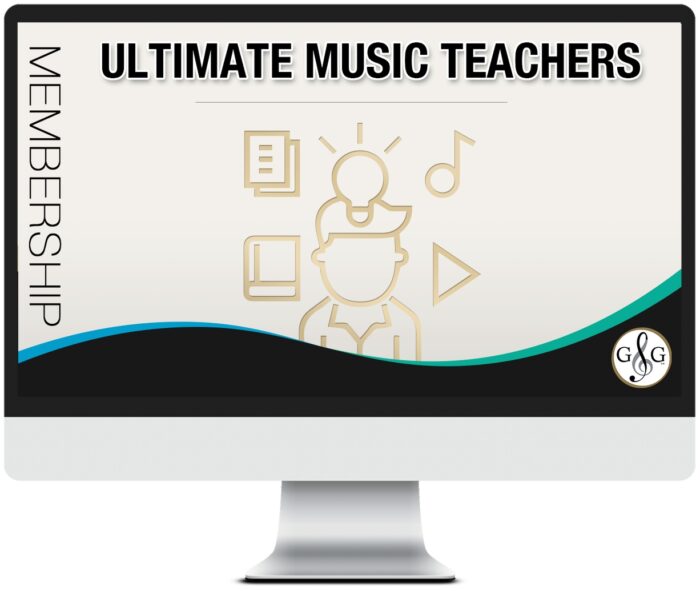How to Teach Music Theory Beginner A Lesson 5
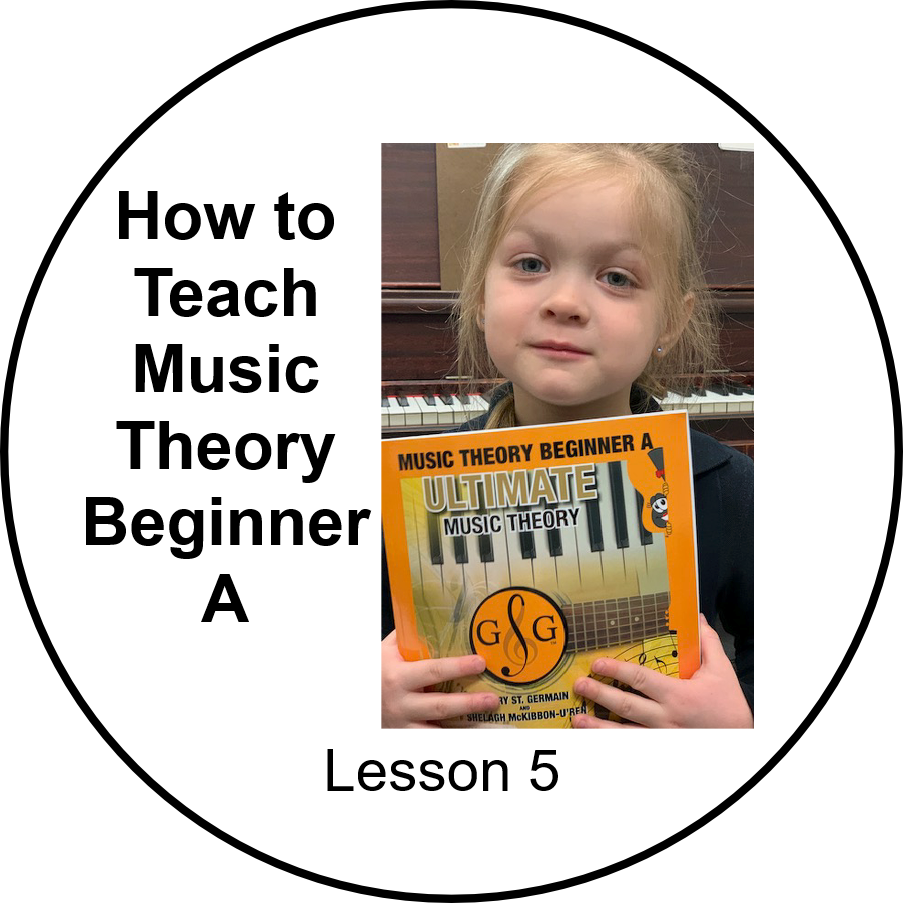
Welcome to the How to Teach Ultimate Music Theory Beginner A Workbook Series - Lesson 5.
The Ultimate Music Theory Beginner A, B and C Workbook Series is the perfect theory supplement for Beginner Students (ALL ages, ANY instrument). The UMT Beginner A, B, C Series works with every Method Series and with every Learning Style.
In this Blog, we will look at how to teach the concepts in the Music Theory Beginner A Workbook Lesson 5. Remember to read the first 5 Blogs in this series:
Music Theory Beginner A Overview
Music Theory Beginner A - Lesson 1
Music Theory Beginner A - Lesson 2
Music Theory Beginner A - Lesson 3
Music Theory Beginner A - Lesson 4
Join me as we explore tips and tricks to incorporate theory, ear training, sight reading and games into every lesson. Let's jump in!
How to Teach Music Theory Beginner A Pages 28 & 29
I love teaching this Lesson! There are so many games that you can play. But the most important part of this Lesson is to ensure that your Student has a way that works for them to remember the names of the White Keys on the Piano.
We have provided one way to remember how to find each White Key. This is, however, not the only way for a student to identify the names of the white keys. Please take the time to see what works for your student!
Here are some ideas:
- C is the WHITE key to the left of the 2 black keys.
- C is the WHITE key at the bottom left of 2 black keys.
- C is the WHITE key below 2 black keys.
- C is the WHITE key down below 2 black keys.
I would love to hear in the comments section how you describe the location of the White Keys to your students.
Personally, I do not like the concept of teaching that "C is after B" as the only way to discover C. In order to have a secure foundation of the keyboard, the student should be able to identify each key all by itself, with no help from finding other keys (or naming all the letter names from the bottom A going up the piano).
I take this one step further - not only do I teach my students how to find each of these white keys individually (and they must be able to use their words to describe the location - and not just "C is this key"), I want them to be able to close their eyes and find C! They have to be able to find that group of 2 black keys (which have a different feel from a group of 3 black keys) and then play the white key C all while keeping their eyes closed. Try it!
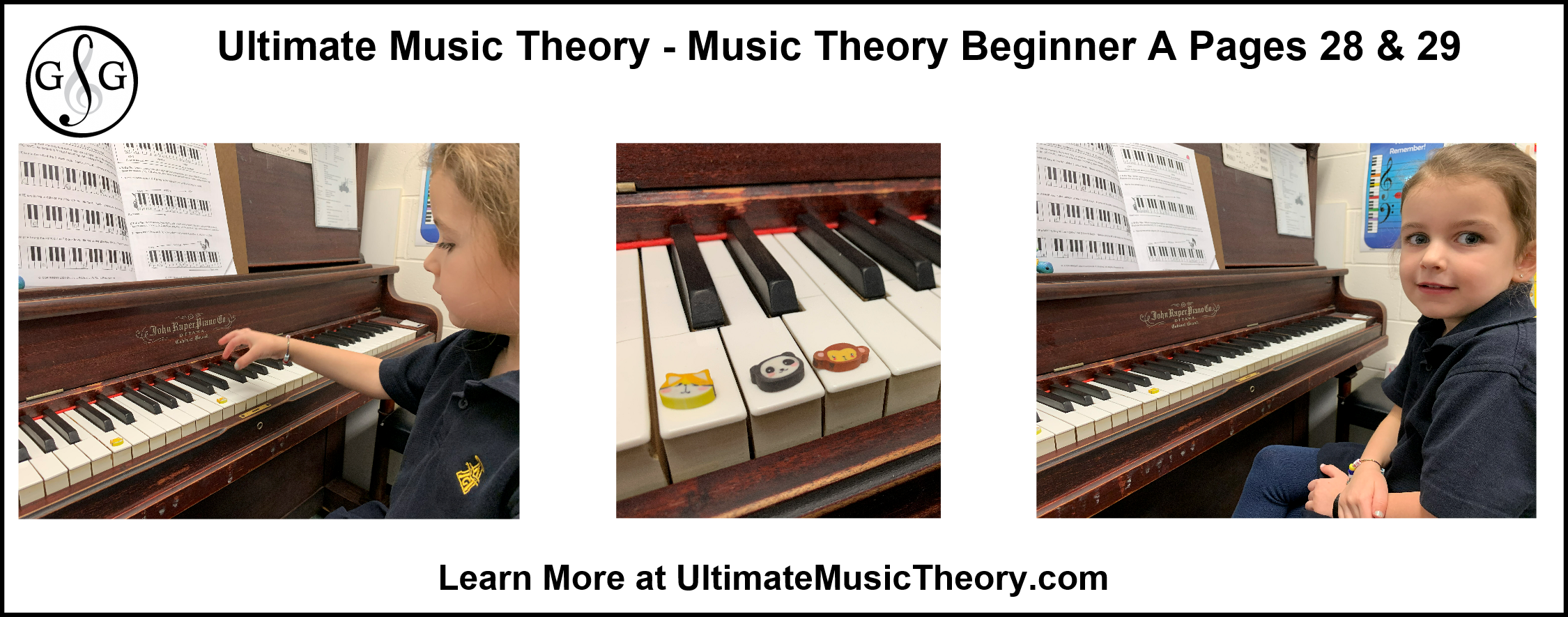
What is an Octave?
On Page 28, we read the Ti-Do Tip: When moving from one key to another key of the SAME letter name, the distance is 8 keys. This is called an OCTAVE. An octave is 8 keys beginning and ending with the SAME letter name.
In order to understand how to count up (or down) the piano in octaves, we need to understand that the 8th key of the first octave must become the 1st key of the next octave. (Confused yet? It most definitely is confusing!)
Let's start with the INCORRECT way to count up the keyboard in octaves. Have your student count up the piano in groups of 8 by counting the white keys "1-2-3-4-5-6-7-8-1-2-3, etc.". Do you notice how the groups start and end on different letter names?
8 keys above C is C, however if we continue counting the next note as 1 again, we are starting on a D and 8 keys above D is D. If we continue counting the next note again as 1, we are starting and ending on an E.
Each of those distances is an octave, but we are not counting up the piano "IN OCTAVES". To count in octaves, each octave must begin and end on the same letter name.
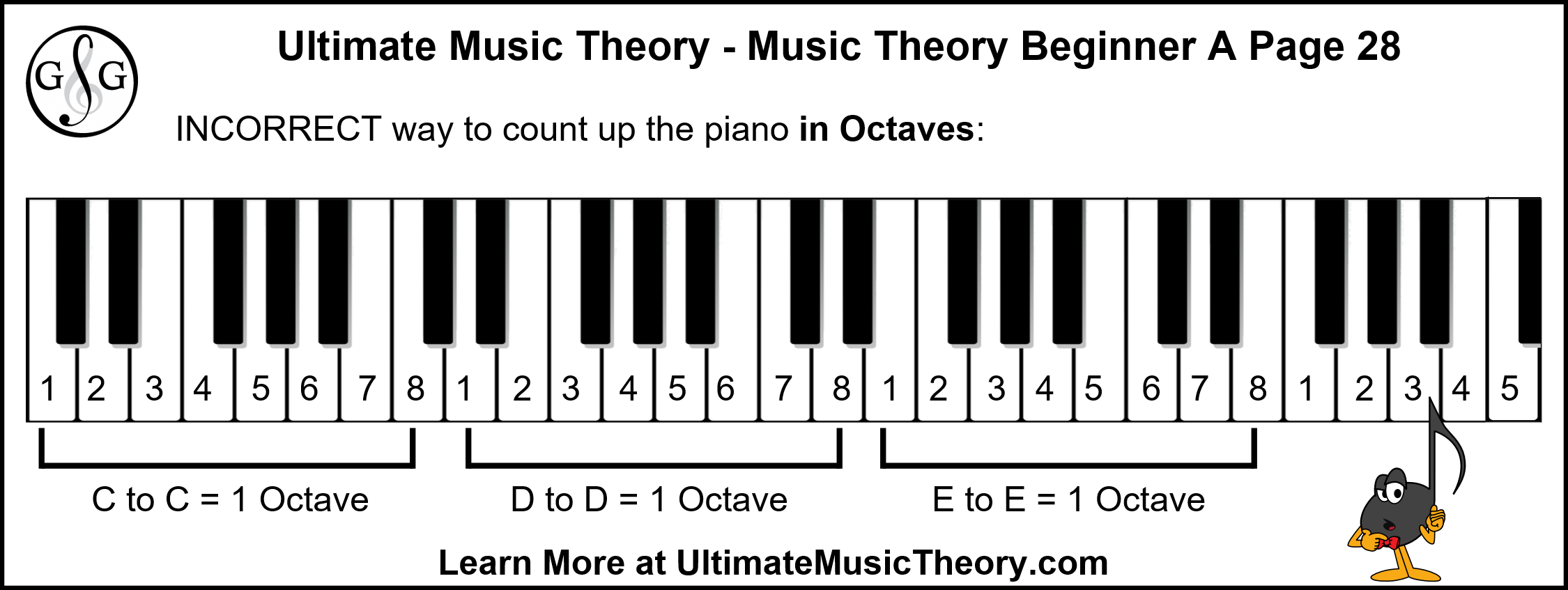
To count in octaves (or to count by octaves), the 8th letter name (the 8th key) is repeated again as Number 1 (the 1st key). This is the only way to count all the octaves from (for example) C to C going up or down the keyboard.
Let's start by finding the first C at the bottom of the piano. That is #1. Play and count each key up to #8. That is a C as well.
Now, to count up the octaves from C to C, we must start counting again with #1 on that C. Therefore, we count 1-2-3-4-5-6-7-8, then we start again by renaming "8" as "1". When counting up or down the keyboard in Octaves from C to C, we must start and end each octave on a C.
Tip: I have my students count up in one big breath saying "1-2-3-4-5-6-7-8", then hold their finger down on that 8th key, take a deep breath and play it again saying "1-2-3-4-5-6-7-8".
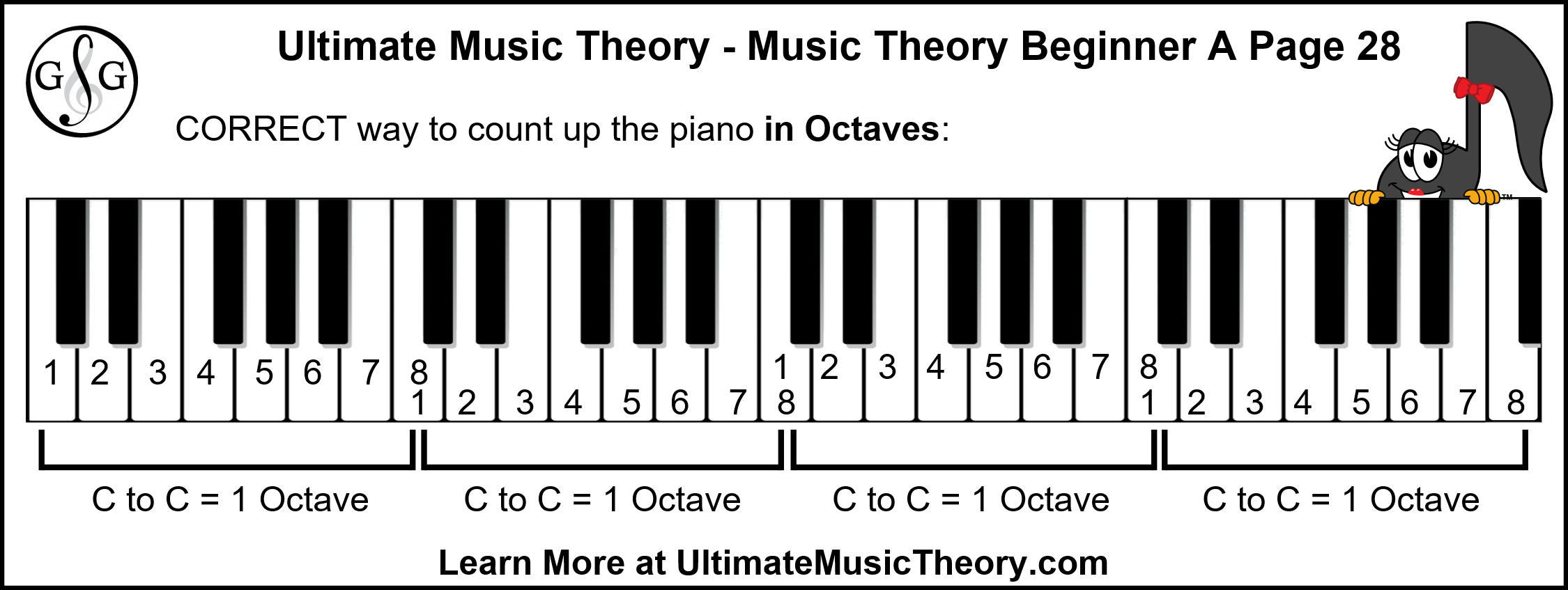
How to Teach Music Theory Beginner A - The White Key Octave Game
You cannot play the piano if you do not know how to find and identify the White Keys on the piano. So spend extra time learning to find the White Keys C, D and E, using the 2-Black Key Group as your foundation.
White Keys can be played at different pitches (down low, in the middle and up high on the keyboard). By playing games at the piano, students have fun learning!
One thing that I have at each of my Teaching Studios is a container of little animal erasers. The erasers do not scratch the piano keys and students can easily move them. I found mine at the Dollar store and I organized mine so that I have 3 sets of 7 different shapes. This means that I can complete a Musical Alphabet (A-B-C-D-E-F-G) at 3 different pitches on the piano.
To play the "White Key Octave Game":
- Start by placing an eraser on the White Key C down low, closest to the the bottom left of the piano.
- Working by going up to the right, find the next group of 2 black keys and place an eraser on the next C. Continue going up to the top of the keyboard.
- Discover that the distance between each C is an octave.
- Review how we need to repeat "8" as "1" again to count the next octave from C to C.
When naming all the octaves from C to C, use the same type of eraser on each C. That visually reinforces how each octave from C to C must start and end on the same letter name (the same type of eraser).
Once you have all the Cs on the piano identified with an eraser, then repeat the game by finding all the White Key Ds. I will leave the C erasers on the piano and then we add the D erasers, then the E erasers.
Your keyboard will now have groups of C-D-E White Keys located with erasers. Guess what you can do now?
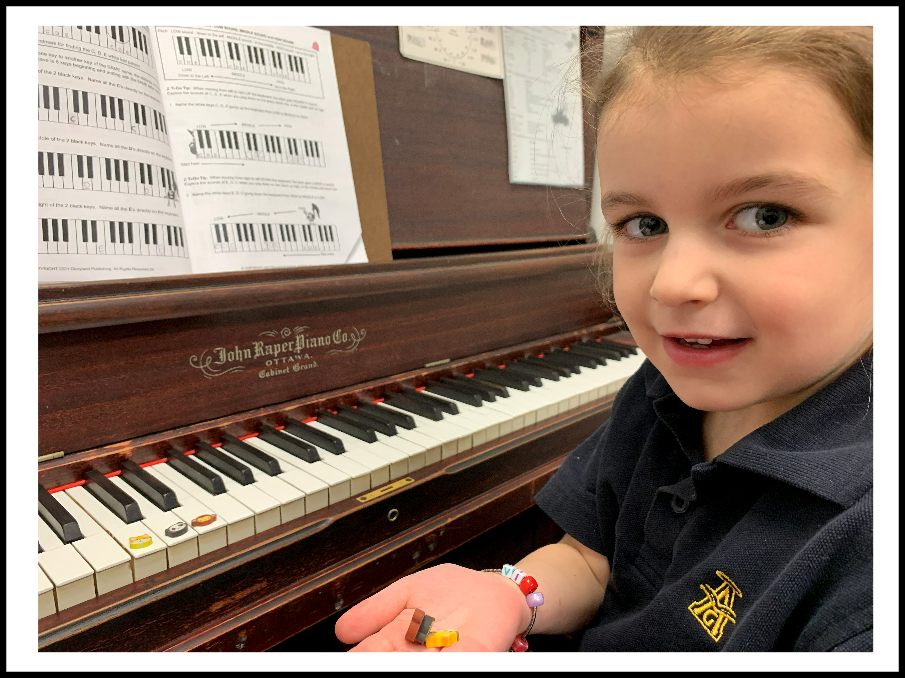
You can play a "Pitch and Direction Game"!
- Play all the C-D-E White Keys separately (one key at a time) saying C, D, E and go UP the keyboard. Discover how the pitches also go up (get higher).
- Play all the C-D-E White Keys separately (one key at a time) saying E, D, C and go DOWN the keyboard. Discover how the pitches also go down (get lower).
- Play all the C-D-E White Keys together (all 3 keys at the same time) and go UP the keyboard. Discover the difference between playing the 3 notes separately (one key at a time) and playing them together (all 3 keys at the same time). Review how the group of pitches also goes up (get higher).
- Play all the C-D-E White Keys together (all 3 keys at the same time) and go DOWN the keyboard. Discover and review the sound, the pitches, as you go down the keyboard.
You are actually pre-teaching the concept of Melody and Harmony here. Melody is playing one note after the other. Harmony is playing 2 or more notes at the same time. This then leads to the future understanding of Melodic Intervals and Harmonic Intervals. Every game you play with your younger student at this level will benefit them later on in their Musical Career. This is also creating a foundation in "ear training" (a requirement on nationally recognized music exam programs). And you are doing all of this while having fun!
How to Teach Music Theory Beginner A Pages 30 & 31
The 3 Black Key Group helps us to find the white keys F, G, A and B. As with C, D and E, there are options for how we can describe the placement of each of these keys.
For F:
- F is the white key to the left of the 3 black keys.
- F is the white key to the bottom left of 3 black keys.
- F is the white key below the 3 black keys.
For G:
- G is the white key between the 1st and 2nd of the 3 black keys.
- G is the white key between the bottom and middle of the 3 black keys.
- G is the white key below the middle black key in the group of 3 black keys.
For A:
- A is the white key between the 2nd and 3rd of the 3 black keys.
- A is the white key between the middle and top of the 3 black keys.
- A is the white key above the middle black key in the group of 3 black keys.
For B:
- B is the white key to the right of the 3 black keys.
- B is the white key to the top right of the 3 black keys.
- B is the white key above the 3 black keys.
Remember, every child may remember using different key words. With my dyslexia, I had trouble remembering "right" and "left", but I could easily remember if I added "top right" and "bottom left". (Just having that second word made me more confident.)
Let me know in the comments section what terminology you use with your students!

Using the Flashcards
When you teach Pages 30 & 31, remember to play the same games and activities as you did on Pages 28 & 29.
Once we have completed those, then I like to add a Flashcard Game! Cut out the Flashcards on Page 96 (at the back of your workbook) or, if you have already cut them out, find the flashcards with the "White Key: ___" pictures. You will have 7 of them (one for each white key on the piano).
I like to put a different eraser on each Flashcard and ask the student to put that eraser on the matching white key on the piano.
How to Teach Music Theory Beginner A - Page 32
On Page 32, I love playing the "Be The Teacher" game with my students.
Question #1 - once the student completes the writing part of this question, we play a Listening Game and they get to Be the Teacher. They have to play all F, G, A & B white keys either going UP the keyboard or going DOWN the keyboard. I get to be the Student and tell them (the Teacher) whether they are playing going UP the keyboard or going DOWN the keyboard.
Question #3 - again, have the student complete the writing part of this question. Then they play all the C, D & E white keys either going UP the keyboard or going DOWN the keyboard.
There is something magical that happens to a Student's self-confidence when they get to make the choice - when they get to "Be the Teacher". It also demonstrates their understanding of the musical concept.
To take this game to the next level, I will ask them to choose to play either a LOW group of white keys, a MIDDLE group of white keys or a HIGH group of white keys. They select a group and play it. I have to tell them what pitch they played at.
Now, sometimes my "listening ears" aren't working perfectly and I might identify a pitch incorrectly. (Ok, I do it on purpose.) This gives me the opportunity to see how they correct my "boo-boo" (my error).
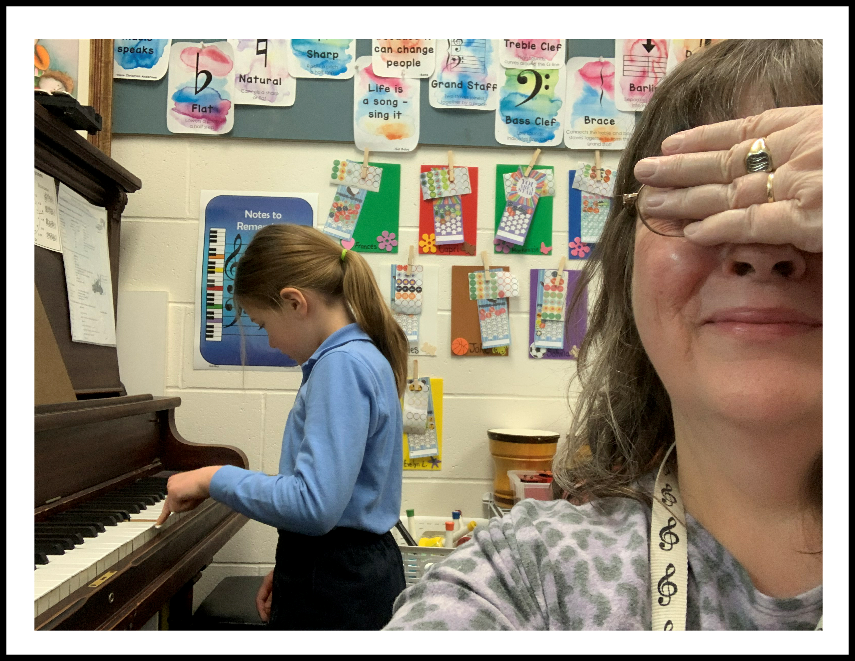
Part of being the "Teacher" is learning how to help the "Student" find the correct answer. I discourage them from saying "that was wrong" or "you were wrong".
I like to review ways that my students can "correct" me in a positive, encouraging manner. Here are some positive and encouraging phrases that we can teach them:
- "I'm going to play that again. Are you ready?"
- "Lets sing along - is our voice going up higher and higher or is our voice going down lower and lower?"
- "This is my low voice. Do these notes sound like the pitch of my low voice?"
How we respond to the mistakes of our students can have a life-long impact on how the student feels about themself when they make a mistake.
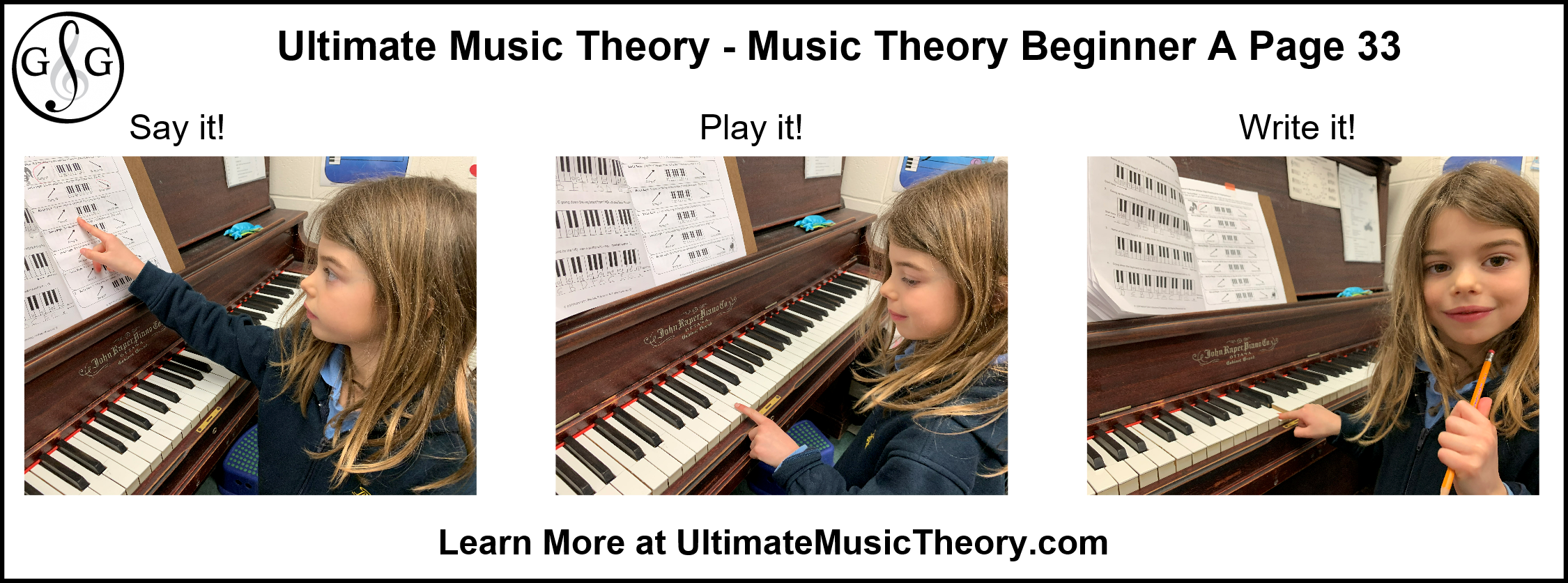
How to Teach Music Theory Beginner A Lesson 4 Page 33
I like to do Page 33 at the lesson. We follow the 3 Steps to Learning Theory - Say it! Play it! Write it!
- The student says the "So-La Says" for the letter name out loud.
- The student plays the white key going UP the keyboard in octaves or going DOWN the keyboard in octaves.
- The student writes their answer (circling either Going UP or Going DOWN).
Remember, you do not have to play every game with every Student. Sometimes our lesson length goes by too fast. But these games and ideas can be used as review at any time.
These game ideas are also perfect for those lessons when the Student just needs to have some fun. Perhaps they had a rough week and didn't get a chance to practice, or maybe they are having a yucky day and just need to do something positive.
Your Music Theory Beginner A Workbook can become the highlight of their day (and of yours too).
With a Smile and a Song,
Shelagh McKibbon-U'Ren
The Ultimate Music Theory Workbook Series - Beginner A, B, C, Prep 1, Prep 2, Basic, Intermediate, Advanced and Complete all-in-one Rudiments!

The UMT Workbooks include 12 Lessons & Review Tests, Music Theory Guide & Chart and 80 Flashcards in each workbook.
- 12 COMPREHENSIVE LESSONS - Simplify complex concepts
- GUIDE and CHART - Memory Joggers for fast and easy reference
- 12 REVIEW TESTS - Accumulative study including final exam
Ultimate Music Theory helps students prepare for nationally recognized theory exams, including the Royal Conservatory of Music Exams.
A Proven Step-by-Step Workbook System!
- LEARN FASTER – Use on any device, phone, tablet, computer
- EXPLORE – Identify written & audio notation
- PLAY – Sight Reading and Ear Training Games and much More!
Students will LOVE the UMT Flashcard System (App powered by Brainscape) that correlates to each lesson in the Beginner A, B, C, Prep 1, Prep 2, Basic, Intermediate & Advanced Workbooks.
Have fun building a foundation in Music Theory, Ear Training, and Sight Reading.
The One and ONLY Music Theory App & Matching Workbook!
Get Access To UMT Worksheets, Games, Activities, Posters, Certificates, Courses, Coaching Calls, Community & More!
Ultimate Music Teachers Membership
♪ LEARN ♪ PLAN ♪ TEACH ♪ GROW
The One & ONLY Ultimate Music Teachers Membership
To Become A UMT PRO!
Your Success Path Starts Here - Go To TeachUMT.com Today!
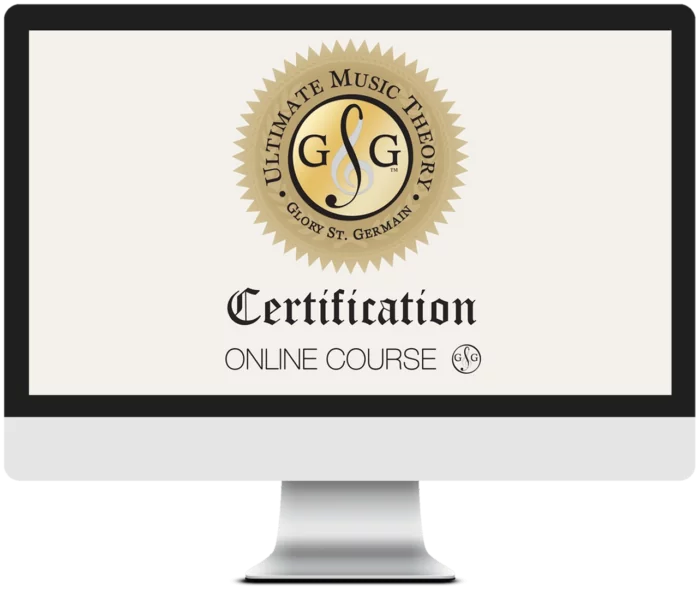
Ultimate Music Theory Certification Elite Educator Program - Online Teacher Training to Elevate Your Income, Impact Your Teaching and Grow Your Expert Music Teaching Business. Get Certified!
Click HERE to discover what you will learn in the Ultimate Music Theory Certification Course. Your professional development Online Teacher Training starts here!
Keep on Learning... With a Smile and a Song!
Shelagh McKibbon-U'Ren

